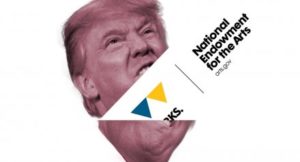Eliminate the NEA save the Federal Tax Code
 The National Endowment for the Arts budget represents a minuscule percentage of the federal budget, but more importantly, it represents an insignificant amount of the total funding provided by the federal government to the arts. At roughly $148 million, some of which goes to overhead and half of the rest is allocated directly to the states equally, the NEA funding as a percentage of the federal budgets is a rounding error. However, there are other ways in which the federal government supports the arts and, while I would argue that eminating the National Endowment for the Arts is not necessarily the tragic, traumatic event portrayed in the arts community, doing away with the other streams of funding would prove disastrous.
The National Endowment for the Arts budget represents a minuscule percentage of the federal budget, but more importantly, it represents an insignificant amount of the total funding provided by the federal government to the arts. At roughly $148 million, some of which goes to overhead and half of the rest is allocated directly to the states equally, the NEA funding as a percentage of the federal budgets is a rounding error. However, there are other ways in which the federal government supports the arts and, while I would argue that eminating the National Endowment for the Arts is not necessarily the tragic, traumatic event portrayed in the arts community, doing away with the other streams of funding would prove disastrous.
I won’t rehearse the many arguments made by proponents of keeping the NEA, the professional and trade arts organizations and Americans for the Arts make the case exceptionally well. The federal government spends significantly more to fund just three arts organizations: The federal government provides direct support to the Kennedy Center ($36 million), The Smithsonian Institution ($840 million), and the National Gallery of Art (over $150 million) and each of the latter two institutions also receives large grants for capital replacement and new buildings. There is no arguing that this funding yields great national arts and science institutions. And while the funding for these organizations is almost never threatened, the large percentage of federal funding has caused a number of instances of government censorship.
But the most significant federal funding for the arts is the indirect funding that occurs, each year, without the political attention or interference from any branch of government. Private funding for the arts reached almost $20 billion in 2016 and has been steadily increasing since 2008. That means $20 billion from individuals, foundations, and corporations, every year. The US, more than any other country, has a private-public partnership with the arts that is unmatched. And when you consider that our individual tax burdens, taken as a whole, are the sum of all the taxes paid less the refunds given to individuals and corporate foundations plus the amount that private foundations are not paying in taxes on their assets, a different picture emerges. Because even if we conservatively assume that the contributions come with a 20% tax benefit, then indirectly the federal government is providing an additional $4 billion to the arts.
Any change in the income tax laws could affect arts giving. So too, the way in which works of art are valued when donated to an art museum (Think, a donor giving a $40 million Picasso to MOMA). The tax laws allow for a valuation of the donation based on the value of the work, not its purchase price. So that collector who buys a Picasso for $1 million and enjoys it hanging in his apartment for 15 years could then donate it to MOMA and receive a $40 million tax deduction (and recognition, adulation, etc). We know that any change to this tax law would have an immediate effect of reducing the donations of art and objects to arts organizations.
This indirect funding mechanism has many benefits: it keeps the government out of the decision-making – if an arts organization is tax exempt the government will comply with the tax refund no matter what the subject or content of the art; it keeps arts institutions well run and customer-focused – the best institutions treat their donors very well and provide them with exemplary experiences; it makes arts organizations more accessible and responsive, particularly with foundation funding – foundations interested in equality and justice demand an accounting from arts organizations of how they serve their communities.
Soon the same members of the executive and legislative branches who are threatening the National Endowment for the A will be overhauling the tax code. The grave danger to the arts, I believe, is not the fate of the NEA, but rather the fundamental role of the federal government (and state and city governments) in funding the arts through the tax code.





